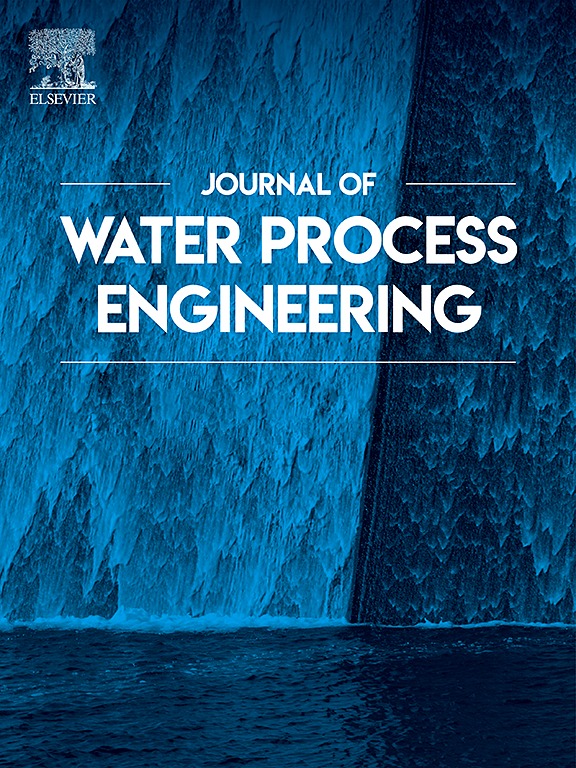固体碳源驱动的异养硝化和好氧反硝化去除海水养殖废水中的氮
IF 6.7
2区 工程技术
Q1 ENGINEERING, CHEMICAL
引用次数: 0
摘要
异养硝化和好氧反硝化(HNAD)可以在好氧条件下同时去除NH4+-N和NO3−-N。该工艺非常适合富氧海洋循环水养殖系统(MRAS)中含氮废水的处理。玉米芯(CC)和花生壳(PS)等天然纤维素材料是废水处理中很有前途的固体碳源。它们广泛可用,成本效益高,对环境友好。本研究开发了一种以CC和PS作为SCSs处理MRAS废水的HNAD工艺。对其脱氮性能和转化途径进行了研究。CC和PS的溶解有机产量分别为0.44 g-COD/g-CC和0.17 g-COD/g-PS。使用CC的HNAD工艺在6天的给药周期内表现出稳定和有效的好氧反硝化作用。NO3−-N和总无机氮(TIN)的去除率分别达到99.71%和96.72%。NO2−-N积累可以忽略不计(<;0.3 mg / L)。与PS相比,CC表现出更显著的表面变化和更高的微生物利用率。它的表面表现出增加的孔隙,凹陷和更大的微生物粘附。NH4+-N的去除是由自养硝化、异养硝化和细胞同化驱动的。异养硝化作用是主要途径。NO3−-N的去除主要通过异养反硝化进行。这些过程的效率很大程度上取决于所使用的碳源的类型。微生物群落分析表明,好氧反硝化细菌和纤维素降解细菌的共存是维持反硝化效率的关键。本研究证实了HNAD反硝化过程的潜在机制,为其在MRAS中的实际应用提供了参考。本文章由计算机程序翻译,如有差异,请以英文原文为准。

Nitrogen removal via solid carbon source-driven heterotrophic nitrification and aerobic denitrification in marine aquaculture wastewater
Heterotrophic nitrification and aerobic denitrification (HNAD) enable the simultaneous removal of NH4+-N and NO3−-N under aerobic conditions. This process is highly suitable for treating nitrogen-containing wastewater in oxygen-rich marine recirculating aquaculture system (MRAS). Natural cellulose materials, such as corncob (CC) and peanut shell (PS), are promising solid carbon sources (SCSs) for wastewater treatment. They are widely available, cost-effective, and environmentally friendly. This study developed an HNAD process using CC and PS as SCSs for MRAS wastewater treatment. The nitrogen removal performance and conversion pathways were investigated. CC and PS had dissolved organic yields of 0.44 g-COD/g-CC and 0.17 g-COD/g-PS, respectively. The HNAD process using CC demonstrated stable and efficient aerobic denitrification over a 6-day dosing cycle. Notably, NO3−-N and total inorganic nitrogen (TIN) removal efficiencies peaked at 99.71 % and 96.72 %, respectively. The NO2−-N accumulation was negligible (< 0.3 mg/L). Compared to PS, CC showed more significant surface changes and higher microbial utilization. Its surface exhibited increased porosity, depressions, and greater microbial adhesion. NH4+-N removal was driven by autotrophic nitrification, heterotrophic nitrification, and cell assimilation. Heterotrophic nitrification was the dominant pathway. NO3−-N removal primarily occurred through heterotrophic denitrification. The efficiency of these processes depended heavily on the type of carbon source used. Microbial community analysis revealed that the coexistence of aerobic denitrifying bacteria and cellulose-degrading bacteria was critical for sustained denitrification efficiency. This study confirmed the underlying mechanisms of the HNAD denitrification process and provided a reference for its practical application in MRAS.
求助全文
通过发布文献求助,成功后即可免费获取论文全文。
去求助
来源期刊

Journal of water process engineering
Biochemistry, Genetics and Molecular Biology-Biotechnology
CiteScore
10.70
自引率
8.60%
发文量
846
审稿时长
24 days
期刊介绍:
The Journal of Water Process Engineering aims to publish refereed, high-quality research papers with significant novelty and impact in all areas of the engineering of water and wastewater processing . Papers on advanced and novel treatment processes and technologies are particularly welcome. The Journal considers papers in areas such as nanotechnology and biotechnology applications in water, novel oxidation and separation processes, membrane processes (except those for desalination) , catalytic processes for the removal of water contaminants, sustainable processes, water reuse and recycling, water use and wastewater minimization, integrated/hybrid technology, process modeling of water treatment and novel treatment processes. Submissions on the subject of adsorbents, including standard measurements of adsorption kinetics and equilibrium will only be considered if there is a genuine case for novelty and contribution, for example highly novel, sustainable adsorbents and their use: papers on activated carbon-type materials derived from natural matter, or surfactant-modified clays and related minerals, would not fulfil this criterion. The Journal particularly welcomes contributions involving environmentally, economically and socially sustainable technology for water treatment, including those which are energy-efficient, with minimal or no chemical consumption, and capable of water recycling and reuse that minimizes the direct disposal of wastewater to the aquatic environment. Papers that describe novel ideas for solving issues related to water quality and availability are also welcome, as are those that show the transfer of techniques from other disciplines. The Journal will consider papers dealing with processes for various water matrices including drinking water (except desalination), domestic, urban and industrial wastewaters, in addition to their residues. It is expected that the journal will be of particular relevance to chemical and process engineers working in the field. The Journal welcomes Full Text papers, Short Communications, State-of-the-Art Reviews and Letters to Editors and Case Studies
 求助内容:
求助内容: 应助结果提醒方式:
应助结果提醒方式:


